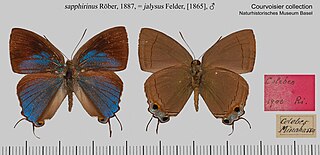
The orange wrasse is a species of wrasse native to the Pacific Ocean from Australia to New Zealand and the Kermadec Islands. It is found in inshore waters at depths from 10 to 50 metres. It can reach a length of 17 centimetres (6.7 in) SL. It can also be found in the aquarium trade.
Teyl is a genus of spiders in the family Anamidae with four described species, all of which are endemic to Australia. It is one of the genera that was placed in the former tribe Teylini. The type species is T. luculentus.

Tajuria maculata, the spotted royal, is a species of lycaenid or blue butterfly found in Asia.

Tajuria is an Indomalayan genus of butterflies in the family Lycaenidae.

Tajuria matsutaroi is a butterfly of the family Lycaenidae first described by Hisakazu Hayashi in 1984. It is endemic to the Philippine islands of Mindanao and Leyte. Forewing length is about 16–19 mm. The butterfly is a rare species. The nominotypical subspecies is found only on Mount Apo on Mindanao island and occurs several times a year.

Tajuria matsutaroi motokoae is a butterfly of the family Lycaenidae. It is a subspecies of Tajuria matsutaroi. This subspecies is rarely found on Leyte island in the Philippines. Its forewing length is 16–19 mm. Subspecies motokoae is distinguishable from the nominotypical subspecies by the following characters of the upperside: 1) ground colour is decidedly darker and clearly tinged with purple, while only slightly tinged with pale purple in subspecies matsutaroi, 2) black border is broader in spaces 1b, 2 and the upper part of the cell on the forewing, 3) in the female, the upperside costal area is blackish, whereas it is whitish in subspecies matsutaroi.

Tajuria mizunumai is a butterfly of the family Lycaenidae. It is found only on Mindanao in the Philippines. It was originally listed as a subspecies of Tajuria dominus, but was changed species status as Tajuria mizunumai by Colin G. Treadaway in 1995 and by H. Hayashiin 2017.

Tajuria deudorix yuhkichii is a subspecies of the butterfly Tajuria deudorix in the family Lycaenidae. The subspecies was first described by Hisakazu Hayashi in 1984. It is found in Palawan in the Philippines.

Tajuria isaeus is a butterfly in the family Lycaenidae. It is found in South-East Asia.

Tajuria illurgis, the white royal, is a butterfly in the family Lycaenidae. It is found in Asia.

Tajuria ister, the uncertain royal, is a butterfly in the family Lycaenidae. It is found in Asia.

Tajuria diaeus, the straightline royal, is a butterfly in the family Lycaenidae. It is found in Asia.

Tajuria mantra, the Felder's royal, is a butterfly in the family Lycaenidae. It is found in Asia.
Pellenes luculentus is a jumping spider species in the genus Pellenes that lives in the Yemen. The female was first described in 2007.

Tajuria berenis is a butterfly in the family Lycaenidae. It was described by Hamilton Herbert Druce in 1896. It is found in the Indomalayan realm.

Tajuria dominus is a butterfly in the family Lycaenidae. It was described by Hamilton Herbert Druce in 1895. It is found in the Indomalayan realm.

Tajuria yajna, the Purple royal, is a butterfly in the family Lycaenidae. It was described by William Doherty in 1886. It is found in the Indomalayan realm.

Tajuria iapyx is a butterfly endemic to the island of Sulawesi. It was described by William Chapman Hewitson in 1865.
Harmochirus luculentus is a species of spiders in the family Salticidae. It is found in Africa, Zanzibar and Yemen.
















